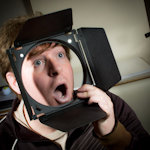The Golden Recipe To Better Photographs
Wed
26 Nov 2014
26 Nov 2014
There is a time of day that photographers love more than any other, they call it golden hour. It is not just golden in terms of colour, though the light does have an attractive golden hue, but it is also valuable and highly prized. As well as a gentle warmth in the colour of the light at this time of day, the lower angle of the sun can lead to more interesting pattern of light and shade, both in the sky and across the landscape. The angle of the sun also makes polarising filters more effective at darkening the sky close to the horizon (whch is the part of the sky you're most likely to see in your photos), and portraits are less likely to have unflattering shadows from a high light-source and squinting subjects.

Look for ways to emphasise the colour of the light during golden-hour
As the name suggests, golden hour is approximately an hour long (although it has fuzzy boundaries), and it starts about an hour before sunset. Golden hour is often confused with sunset, but it should be noted that golden hour is definitely what most people would just call 'daylight', it isn't about the dramatic and vibrant colours of sunset, which require a certain approach, but is a more general-purpose type of light that can be just as good with portraits and architectural details as it is with landscapes.
When exactly golden hour is depends on the time of year and your latitude as it changes time the same way sunset does. It isn't always an hour either, the length will vary with your latitude, as the closer to the equator you are, the steeper the angle of the sun's path and the quicker the transition from daylight to darkness. This website will help you calculate the golden hour for your location as well as downloading an app for some smartphones.
Of course you will also see that there are two golden hours per day, one in the morning and one in the evening. The advantage of going out early in the morning is that you are likely to be alone, should you want to capture a place without the crowds; landscape photographers also particularly enjoy the stillness of bodies of water in the morning, and the mist you often get.
During golden hour, the sun is fairly low down in the sky, and therefore the light isn't as bright. This sometimes means that a tripod is required to get the best shots. While a tripod isn't totally necessary, and if you're photographing people and require short shutter speeds you'll find there is plenty of light for you, you can really benefit from a tripod to allow for longer exposure times.
When photographers aren't raving about the quality of light at golden-hour, they're raving about the quality of light just after a storm, or when it's raining, or in partial cloud cover. All of these can combine with golden-hour to produce the ultimate 'good-light'. During golden hour, the sun can sneak rays of light beneath heavy storm clouds, or illuminate droplets of water from the side, or behind, making them stand out more.
Ideas for taking advantage of golden hour
Golden hour presents many opportunities to take advantage of the quality and colour of the light and position of the sun in the sky, and I've listed a few ideas below. Of course you don't have to go out and do something particularly with the golden colour, or silhouettes. Golden hour is perfect for just going out with your camera and taking photographs of people and places, most kinds of photography can benefit from the quality of light.
- Take a portrait with the subject's back to the sun and fill-in flash
- Photograph silhouettes against the sun
- Photograph a group of people with long shadows
- Photograph architectural details, with the side-lighting helping to pick out the details

Articles about photography, tips and tricks, insights into the world of commercial photography and the marketing industry from a photographer's perspective, and the occasional humorous rant. Brought to you by Will McAllister, a commercial photographer based in God's own county of Cumbria.
PREVIOUS BLOG POSTS
